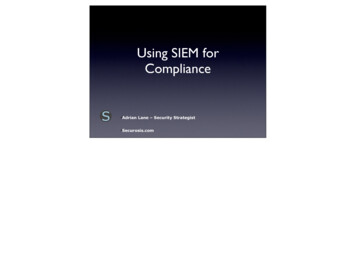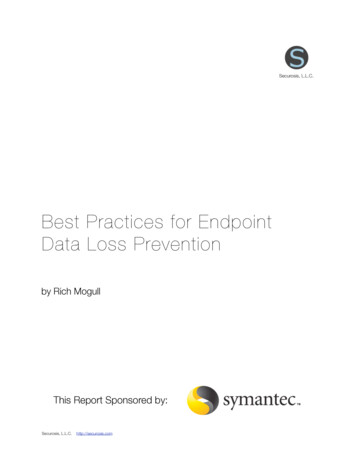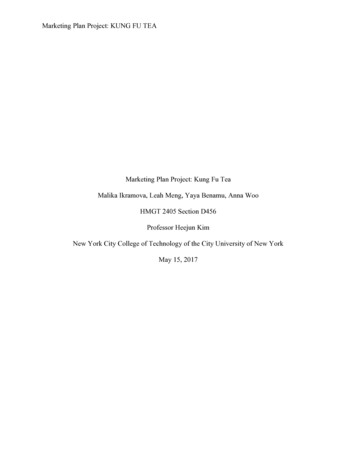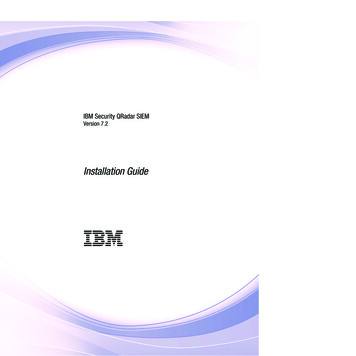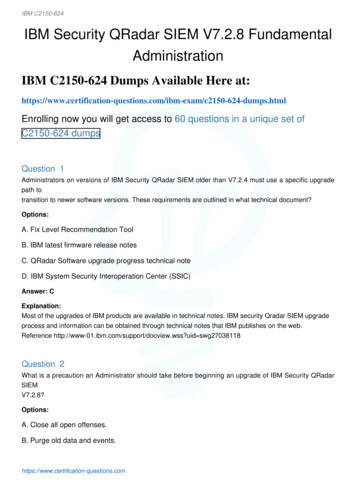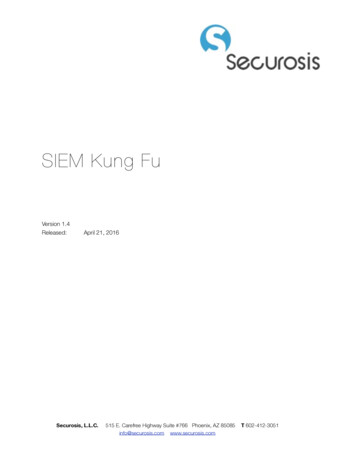
Transcription
SIEM Kung FuVersion 1.4Released:April 21, 2016Securosis, L.L.C.515 E. Carefree Highway Suite #766 Phoenix, AZ 85085info@securosis.com www.securosis.comT 602-412-3051
Author’s NoteThe content in this report was developed independently of any sponsors. It is based on materialoriginally posted on the Securosis blog, but has been enhanced, reviewed, and professionally edited.Special thanks to Chris Pepper for editing and content support.This report is licensed by Intel Security.www.intelsecurity.comMcAfee is now part of Intel Security. With itsSecurity Connected strategy, innovative approachto hardware-enhanced security, and unique McAfeeGlobal Threat Intelligence, Intel Security isintensively focused on developing proactive, provensecurity solutions and services that protectsystems, networks, and mobile devices forbusiness and personal use around the world. IntelSecurity is combining the experience and expertiseof McAfee with the innovation and provenperformance of Intel to make security an essentialingredient in every architecture and on everycomputing platform. The mission of Intel Security isto give everyone the confidence to live and worksafely and securely in the digital world.CopyrightThis report is licensed under Creative Commons AttributionNoncommercial-No Derivative Works .0/us/Securosis — SIEM Kung Fu"2
SIEM Kung FuTable of ContentsSIEM Fundamentals4Advanced Use Cases7Getting Started and Sustaining Value13Summary17About the Analyst18About Securosis19Securosis — SIEM Kung Fu"3
SIEM FundamentalsAnother SIEM research paper? Really? Why are we still talking about SIEM? Isn’t it old technology?Hasn’t it been subsumed by new and shiny security analytics products and services? Be honest —those thoughts crossed your mind, especially because we have published a lot of SIEM researchover the past few years. We previously worked throughSecurity monitoring needs tobe a core, fundamental, aspectof every security program.SIEM — in various flavors,using different technologiesand deployment architectures— is how you do securitymonitoring.the basics of the technology and how to choose theright SIEM for your needs. A bit over a year ago welooked into how to monitor hybrid cloud environments.Security monitoring needs to be a core, fundamental,aspect of every security program. SIEM — in variousflavors, using different technologies and deploymentarchitectures — is how you do security monitoring. Soit’s not about getting rid of the technology — it’s aquestion of how to get the most out of existinginvestments, and ensure you can handle modernadvanced threats.We understand how SIEM got its bad name. Early versions of the technology were hard to use andrequired significant integration just to get up and running. You needed to know what attacks youwere looking for, and unfortunately most adversaries don’t share their attack playbooks before theycome knocking on your door. Operating an earlySIEM required a ninja DBA, and even then queriescould take hours to complete — even days for fullreports. Adding a new use case with additionalsearches and correlations required an act ofCongress and a truckload of consultants. It’s nosurprise organizations lost patience with SIEM. Sothe technology was relegated to generatingcompliance reports and some very simple alerts,while other tools were used to do ‘real’ securitymonitoring.But as with most other areas of security technology, SIEM has evolved. Security monitoringplatforms now support a bunch of additional data types, including integration with threat intelligence,reputation services, and network packet capture. The architectures have evolved to scale moreefficiently and have both built-in fancy new ‘Big Data’ analytics engines as well as integrating withSecurosis — SIEM Kung Fu"4
3rd party analytics to improve detection accuracy, even for attacks you haven’t seen before. Threatintelligence is integrated into the SIEM directly, so you can look for attacks affecting otherorganizations, so you are ready if/when they hit you.This SIEM Kung Fu paper will provide what you need to know to get the most out of your SIEM, andsolve the problems you face today by increasing your capabilities (the promised Kung Fu). But firstlet’s revisit SIEM’s key use cases and what is typically available out of the box with SIEM tools.AlertingThe original use case for SIEM was security alert reduction. IDS and firewall devices were pumpingout too many alerts, and you needed a way to figure out which required attention. That worked for alittle while, but then adversaries got much better, and learned to evade many of the simplecorrelations available with first-generation SIEM. So the key objective of using the SIEM needs toevolve to getting actionable alerts.Many different techniques are available to detect attacks. You can hunt for anomalies that kindasorta look like they could be an attack, or you can perform very sophisticated analytics on a widevariety of data sources to detect known attack patterns. What you cannot do any more is dependon simple signature-based detection because modernattacks are too complicated. You need to analyzeinbound network traffic (to find reconnaissance), deviceactivity (for signs of compromise), and outbound networktraffic (for command and control / botnetcommunications) as well. And that’s a simplified view ofhow a multi-faceted attack works. Sophisticated attacksrequire sophisticated analysis to detect and verify.Out of the box a SIEM offer a number of differentpatterns to detect attacks. These run the gamut fromYou need to analyze inboundnetwork traffic (to findreconnaissance), deviceactivity (for signs ofcompromise), and outboundnetwork traffic (for commandand control / botnetcommunications) as well.simple privilege escalation to more sophisticated botnetactivity and lateral movement. Of course these built-indetections are generic and need to be tuned to your specific environment, but they can give you ahead start finding malicious activity in your environment. This provides the quick win which hashistorically eluded many SIEM projects, and builds momentum for continued investment to add moreadvanced use cases.SIEM technology has advanced to where it can find many attacks and alert you to areas of interestwithout a lot of integration and customization, including brute force login attempts, suspiciousegress traffic, privilege escalation, critical system file changes, log source unavailability and/orvolume spikes, web application misuse, and hundreds of others. But to detect advanced andtargeted attacks by sophisticated adversaries, a tool can only get you so far. You need to evolve howyou use security monitoring tools. You cannot just put a shiny new tool in place and expect to findadvanced adversaries.Securosis — SIEM Kung Fu"5
ForensicsOnce you have determined an attack is under way — more accurately once you have detected oneof the many attacks currently taking place in your environment — you need to investigate anddetermine the extent of the damage. We have documented the incident response process,especially within the context of integrating threat intelligence, and SIEM is a critical tool to aggregatedata and provide a platform for search and investigation.Out of the box a SIEM will enable responders to search through aggregated security data. You stillneed a talented responder to really dig into an attack and figure out what’s happening. Althoughsome tools offer visualizations to help users see anomalous activity and figure out where certainevents occurred on the timeline, which certainly makes the responder more efficient. No tool cantake incident response from cradle to grave. A SIEM will not be the only tool your incidentresponders use. But in terms of efficiently figuring out what’s been compromised, the extent of thedamage, and an initial damage assessment, the SIEM should be a keystone of your process.Especially given the ability of a SIEM to collect, correlate and analyze on many types of critical threatintelligence including threat feeds and user and networkbehavior, providing more granularity and enabling you tobuild a timeline of what really happened.ComplianceFinally, SIEM remains instrumental for generatingcompliance reports, which are still a necessary evil tosubstantiate the controls you have in place. Thisdistinctly unsexy requirement seems old hat, but youdon’t want to go back to preparing for your assessmentsThis distinctly unsexyrequirement seems old hat,but you don’t want to go backto preparing for yourassessments by wadingthrough reams of log printoutsand assembling data in Excel,do you?by wading through reams of log printouts andassembling data in Excel, do you? SIEM tools ship withdozens of reports to show the controls in place and map them to compliance requirements so youdon’t need to do it manually.Another reason the compliance use case is still important is the skills gap every security teamstruggles with. If you have valuable and scarce security talent generating reports to make an auditorgo away, they aren’t verifying and triaging alerts, tuning detections to find new attacks, orinvestigating incidents. Automating as much compliance as possible remains an important SIEM usecase.As we mentioned in earlier SIEM research, a lot of these basic use cases can (and should) beimplemented during a PoC process. That way you can have the vendor’s sales engineers helpkickstart your efforts and get you up and running with their out-of-box capabilities. But asophisticated attacker targeting your organization will not be detected by basic SIEM correlation.Through the rest of this paper we will dig into more complicated use cases, which require pushingthe boundaries of what SIEM does and how you use it.Securosis — SIEM Kung Fu"6
Advanced Use CasesGiven the advance of SIEM technology, the use cases described above are very achievable. Butbetween the availability of more packaged attack kits leveraged by better organized (and funded)adversaries, and the insider threat, you need to go well beyond what comes out of the SIEM box, orcan be deployed during a one-week PoC, to detect real advanced attacks.As we dig into more advanced use cases we will tackle how to optimize your SIEM to both detectadvanced attacks on your employees, and also monitor application technology stacks to preventattackers from getting in through holes in your application infrastructure. In the past we havegrouped use cases by which adversaries they are focused on, but that never worked out very wellbecause there are great similarities between detecting an external actor and a malicious insider. Theyall want your stuff. Sure, you have different inspection points depending on whether you are dealingwith internal or external actors, yet in almost every successful attack, the adversary gains presenceon the network and therefore technically becomes an insider.Instead we will break up advanced use cases by target.The most common path nowadays is to compromisedevices (typically through an employee), escalateprivileges, and move laterally to achieve the mission.Alternatively an attacker might target the applicationstack directly from the outside, to establish a path to thedata center which does not require any lateralmovement. Fortunately a properly utilized SIEM canThere are great similaritiesbetween detecting an externalactor and a malicious insider.They all want your stuff.detect both.Attacking EmployeesThe most prominent attack vector we see in practice today is the so-called advanced attack, whichinvolves a multi-stage process of attacker doing reconnaissance, building specific exploits to gainpresence on a network, communicating with a central location to get further instructions, movingthrough the target’s environment to achieve the mission, and then exfiltrating the stolen data. Theseattackers are well funded and patient. They figure out what is going to work to achieve their missionand they do it.These advanced adversaries don't use typical attacks that you've seen before. They evade your IPSdevices and make mincemeat of the traditional endpoint protection on your devices. Theycompromise devices and move laterally within your organization, compromising more devices,burrowing deeper until they eventually access the information they've been tasked to steal.Securosis — SIEM Kung Fu"7
Detecting this kind of attack requires a different approach, involving looking for anomalous behaviorat a variety of levels within the environment. Fortunately employees (and their devices) should bereasonably predictable in what they do, which resources they access, and their daily traffic patterns.In a typical device-centric attack an adversary follows a predictable lifecycle: performreconnaissance, send an exploit to the device, and escalate privileges; then use that device as abase for more reconnaissance, more exploits, and to burrow further into the environment. We havespent a lot of time on how threat detection needs to evolve and how to catch these attacks usingnetwork-based telemetry.Leveraging your SIEM to find these attacks is similar; it involves understanding the trail the adversaryleaves, the resulting data you can analyze, and patterns to look for. All the clues are changes fromthe normal state. During any attack the adversary changes something on the device under attack.Whether it is device configuration, creating new user accounts, increasing account privileges, or justunusual traffic flows, the SIEM has access to all this data to detect attacks. The key is to set abaseline of normal activity when implementing the SIEM and keeping that baseline up to date overtime to pinpoint the anomalies.Initial usage of SIEM technology was entirely dependent on infrastructure logs, such as from networkand security devices. That made sense because SIEM was initially deployed to stem the flow ofalerts streaming in from firewalls, IDS, and other network security devices. But that very limited viewof activity eventually become easy for adversaries to evade. So over the past decade manyadditional data sources have been integrated into SIEM to provide a much broader view of yourenvironment. Endpoint Telemetry: Endpoint detection has become the new shiny thing. There is a tonof interest in performing forensics on endpoints, and if you are trying to figure out how theproverbial horse left the barn, endpoint telemetry is great. Another view is that devices aretargeted in virtually every attack, so highly detailed data about exactly what’s happening onan endpoint is critical for both incident response and detection. And this data (or theassociated metadata) can be instrumental when watching for the kind of change that mightindicate an active threat actor that requires immediate triage and action. Threat Intelligence: Finally, you can leverage external threat data and IP reputation topinpoint egress network traffic headed places you can recognize are bad. Exfiltration nowtypically includes proprietary encryption, so you aren’t likely to catch the act through contentanalysis — instead you need to track where data is headed. You can also use threatintelligence indicators to watch for specific new attacks in your environment, as we havediscussed ad nauseam in our threat intelligence and security monitoring research. Identity Information: Once an adversary has a presence in your environment, they willalmost inevitably go after your identity infrastructure, because that is usually the path of leastresistance for access to valuable data. You need access to identity stores so you can watchSecurosis — SIEM Kung Fu"8
for new account creation and new privilege entitlements, which are both likely to identifyattacks in process. Network Flows: The next step in the attack is to move laterally within the environment,and move data around. This trail can be detected in network flows. Full packet captureprovides the same information with finer granularity, in exchange for more demanding datacollection and analytics.As mentioned above, the key to using this data to findadvanced attacks is to establish a profile of what’sKeeping your baseline currentand minimizing false positivesare critical to using SIEM forthis use case. You needongoing effort and tuning.normal within your environment, and then look forvariation. Anomaly detection remains one of the topways to figure out when attackers are having their way inyour environment. Keeping your baseline current andminimizing false positives are critical to using SIEM forthis use case. You need ongoing effort and tuning. Ofcourse no security monitoring tool just works — so go inwith your eyes open to the amount of work required.Multiple Data PointsSpeaking of minimizing false positives, how can you? More SIEM projects fail due to alert exhaustionthan for any other reason, so don’t rely on any single data point to determine that an alert islegitimate and demands investigation. Reduction of false positives is even more critical because ofthe skills gap which continues to flummox security professionals. Using a SIEM you can link togetherseemingly disconnected data sources to validate alerts and make sure the alarm is sounded onlywhen it should be.But what does that look like in practice? You need to make sure a variety of conditions are matchedbefore an alert fires. And increase the urgency of alerts which trigger more conditions. A simplifiedexample illustrates what you can do with the SIEM you likely already have.1. Look for device changes: If a device suddenly registers a bunch of new system filesinstalled, and you aren’t in the middle of a patch cycle, there may be something going on. Isthat enough to pull the alarm? Probably not, so you’ll want to look for more attackindications.2. Track identity: Next you see a bunch of new accounts appear on the device, and then thedomain controller comes under attack as a means to dig deeper within your environment.Once the domain controller falls, it is pretty much game over, because the adversary canthen set up new accounts and change entitlements; thus getting alerts on domain controllerattacks is essential.Securosis — SIEM Kung Fu"9
3. Look for internal reconnaissance: Finally you’ll see the compromised device scanningeverything else on the network, both so the attacker can gain his/her bearings, and also foradditional devices to compromise. Traffic on internal network segments should be prettypredictable, so variations from typical traffic flows usually indicate something funky.But can any of these individual data points conclusively indicate an attack? There’s no smoking gun.But if you see a cluster of multiple indicators that’s not great and definitely warrants investigation.The current generation of SIEMs come with a variety of rules or policies to look for common attackpatterns out of the box. These platforms also have more advanced analytics that can identify attackpatterns happening in the environment by taking a baseline and then looking for anomalous activity.These capabilities are helpful for getting started. Although to really take advantage of the SIEM andfind uncommon attacks, you’ll need to customize the tool and the analytics for your environment.When necessary, advanced adversaries will use malware and social engineering tactics you haven’tseen before and therefore you won’t have a detection built into the SIEM. In this case, you’ll use thebehavioral and data analytics within the SIEM to identify these unknown attacks, refining yourthresholds for alerts; and increasing accuracy and reducing false alarms.Application Stack AttacksWe alluded to this above, but to us an “application stack attack” is not just a cute rhyme, but theway a sophisticated adversary takes advantage of weaknesses within an application or another partof an application stack to gain a foothold in your environment to access data of interest. There are anumber of application stack data s
right SIEM for your needs. A bit over a year ago we looked into how to monitor hybrid cloud environments. Security monitoring needs to be a core, fundamental, aspect of every security program. SIEM — in various flavors, using different technologies and deployment architectures — is how you do security monitoring. So
